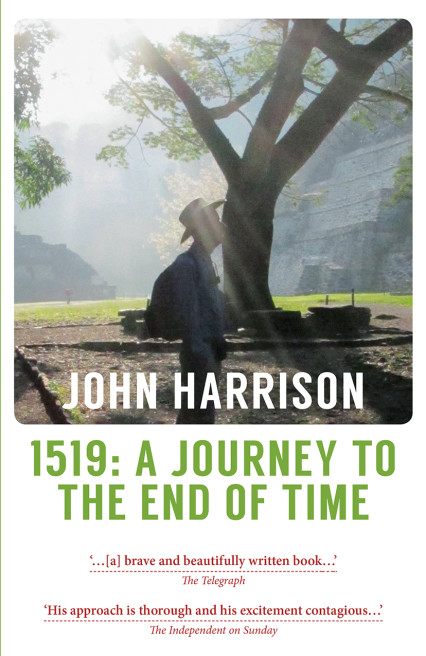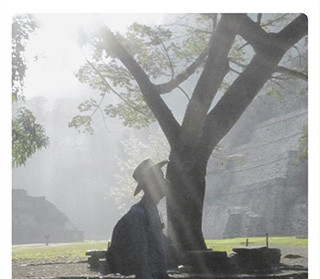Parthian, 337 pp
Travel writing is biography, history, sociology, geology, botany, ornithology. The flavour of a particular author comes from the blend he or she makes of the unfolding material before his or her eyes and ears. Tobias Smollett is all bilious offence in response to sheer foreignness. Jonathan Raban’s strength is his reconstruction of random encounters with his acute ear for vernacular phrasing. John Harrison’s book is a dual journey, Mexico interspersed with a half dozen interludes of hellish journeys no more than a few miles distant from his London home.
Mexico has a depth of historical texture. The first sight on approach to the maes at Hay-on-Wye is the great bulk of a Toltec head. The Mayas built a mathematics of extraordinary beauty and invention. In the art of Rivera, Orozco and Siqueiros Mexico’s Revolution unleashed a public declarative art that has no equivalent anywhere. Harrison himself sees Rivera murals in Tlaxcala’s town hall. He visits the high points of Maya culture, like the frescos of Bonampak with their barely dimmed luminous blues, but the book’s principal topic is contained in the title. The collision of Spain with the states which prevailed on the far side of the Atlantic was merciless and relentless.
 Harrison is known as a prize-winning witness to the spectrum of the hues of blue in the Polar Regions. The steamy heat of Vera Cruz could not be a greater climatic contrast but he is ever alert to the movement and colour around him. He starts his book at the tip of the Yucatan peninsula – “the anvil on which the Caribbean beats” – and the location of the early encounters between the forces of Europe and the Americas. His first sight is of frigate birds that fly by at eye level, their wing length greater than all but the largest albatross. He relishes later the colours of the region’s fine pottery, the earth providing contrasts of black with ochre and black with russet.
Harrison is known as a prize-winning witness to the spectrum of the hues of blue in the Polar Regions. The steamy heat of Vera Cruz could not be a greater climatic contrast but he is ever alert to the movement and colour around him. He starts his book at the tip of the Yucatan peninsula – “the anvil on which the Caribbean beats” – and the location of the early encounters between the forces of Europe and the Americas. His first sight is of frigate birds that fly by at eye level, their wing length greater than all but the largest albatross. He relishes later the colours of the region’s fine pottery, the earth providing contrasts of black with ochre and black with russet.
Mexico itself is preceded by a visit to the homeland of the Conquistadors. Extremadura in Spain is the harshest of European landscapes and Harrison is in both Medellin and Trujillo, home of the brothers Pizarro, the conquerors of the Incas. He looks to the great historian Fernand Braudel to emphasise just how harsh was this area that forged the adventurers of imperial Spain. The bulk of Europe had barely enough soil of requisite quality to provide food for its cities. The trees in this region of Spain were long gone and the presence of three million Merino sheep by 1450 was a disaster of soil erosion. It is little surprise that the assault on Mexico was so uncompromising. Two of the first Maya were seized and used as translators but not before being baptised and, their original names unknown, being renamed Julian and Melchior.
Harrison looks to the big picture of history. He has small time for theorists – “career academics” – who extrapolate cultural defeat into civilisational deficiency. The once empires of the present Latin American countries had lifespans longer than those of Holland, France or Britain. The Aztecs fell because of persistent aggression against their neighbours. Overt power masked vulnerability; not unlike the Muscovy of 2015, they had few friends.
He is alert to the persistence of the pre-Colombian culture. Puebla may be long-term host to a vast Volkswagen plant but the southern states are still assembled around an economics rooted in kin and group. Catholicism sits on top of beliefs that reach back millennia. To enter a church like that of Chamula in Chiapas is to be in a world of utter theological strangeness. “Look in a hotel mirror,” Harrison writes, “and the world seems much like any other Latin country. Look in a Native obsidian mirror; panther-dark figures are behind you in the room.”
Harrison does not embrace every aspect of Mexico. The drug wars of the northern states are far from the locus of his attention. Mexico’s location next to the vastness of the United States, and the even vaster Canada, lends a false impression as to its size. It is eight times the size of the United Kingdom or, as 1519 illustrates, Tijuana is closer to Juneau than it is to Cancun.
The biggest pyramid in the Americas is that of Cholula., the original name for the city tlachihualtépetel meaning “the mountain made by hand.” Its nearest city is Puebla, with its restaurant specialism a mouth-watering meat soaked in chili and chocolate. Harrison rarely touches on his diet but amidst the ruins of El Tajin he mentions that half his calorie intake is comprised of guacamole and milk flavoured with vanilla. Tortillas and rice without an abundance of sauce are beyond him. The reason is a shortage of saliva and a protective mucous that wraps itself around food of any solidity.
The cause is the subject of a scattering of chapters interwoven between his Mexican travels, no more than thirty-one pages in total. The first indication comes during a local walk. The pavement feels like a slack trampoline and the first remedy sought is two pints of Greene King IPA. A recurrence of the experience puts him on the treadmill of GP, blood tests, x-ray and scan. The last reveals a shadow. “Probably a cyst filled with fluid,” the consultant reassures; “We’ll keep an eye on it.”
In preparation for a reading at Rhosygilwen his voice falters and a soreness of the throat does not heal. More medical exploration reveals a shadow at the tongue’s base. “I notice they always talk of treatment, not cure,” he notes. He knows John Donne and “No man is an Island…” For the cancer patient with a low probability of survival it is not so. “I look across the deadly waters… separating me from the main.” He knows his Kuebler-Ross and remembers a Pontcanna drinking companion with the same diagnosis.
The course of his treatment is given in detail and unremitting harshness. “Fear is under control. I find I am content and almost happy,” he is able to say. But radiation treatment and chemotherapy in parallel are appalling. He shrinks physically, even to his feet so that his shoes grow too large.
He remains a writer and a traveller. “Weetabix with banana tastes like brake-pads soaked in battery acid.” The frescos of Central America are besotted with blood. Harrison’s dreadful two years might well have flowed into the main Mexican narrative. But that would depress the point of travel chronicle, that the destination should become the person and not vice versa. Tourism is its reverse; forty-five percent of the suitcases that pass through Britain’s summer airports contain teabags and factory-prepared sausages.
Writers are always indebted to those who have gone before. Harrison pays tribute to Bernal Diaz. On arrival in Yucatan he was aged twenty-four, a soldier, but also a writer. Without him, says the author, “our picture of the human contact between these two worlds would usually remain monochrome. He can make it blaze into colour.” Later, Mexico’s Day of the Dead puts him in mind of Malcolm Lowry in Cuernavaca. Graham Greene’s The Lawless Roads is a chronicle of a journey of arduous hardship but Harrison is a sceptic on the balance of the Catholic view that was to provide the material for The Power and the Glory. The conquest of Mexico has been addressed by a wealth of historians starting with the mammoth work of W H Prescott in the Victorian era. From modern authors Harrison makes particular recommendation of Hugh Thomas and Inga Clendinnan. 1519: A Journey to the End of Time is a fine successor to Where the Earth Ends, Cloud Road and Forgotten Footprints.











